Study on Forest and Grassland Ecological Space Structure in Eyu Mining Area and Potential Alternatives for Enhancing Carbon Sequestration
Abstract
1. Introduction
2. Materials and Methods
2.1. Overview of the Study Area
2.2. Data Source and Processing
2.3. Methods
2.3.1. Identifying the Spatial Extent of F&GES
Ecological Sources
Ecological Corridors
2.3.2. Evaluation of the Structure of F&GES
Evaluation of Connectivity
Evaluation of Topological Characteristics of F&GES Structure
2.3.3. Evaluation of Carbon Sequestration Effects of F&GES
2.3.4. Optimization of F&GES
Evaluation of the Coordination Degree between Carbon Sequestration and Connectivity in F&GES
2.3.5. Optimization Model of the Coordination Degree between Carbon Sequestration and Connectivity in F&GES
2.3.6. Robustness Analysis of F&GES Structure
3. Results
3.1. F&GES in Eyu
3.1.1. Structure and Spatial Extent of F&GES
3.1.2. Topological Relationships of F&GES
3.1.3. Connectivity
3.2. Carbon Sequestration Effect of F&GES in Eyu County
3.3. Optimization of F&GES Structure in Eyu County
3.4. Evaluation of Optimization Effects
3.4.1. Comparison with Other Models
3.4.2. Resilience Assessment
3.4.3. Comparison of Carbon Sequestration Effects
4. Discussion
4.1. Optimization Strategies to Enhance Connectivity and Carbon Sequestration in F&GES
4.2. Optimization of F&GES Contributes to Forest and Grassland Management in Mining Areas
4.3. Optimizing F&GES to Increase Carbon Sequestration in Mining Areas
4.4. Limitations and Future Research Directions
5. Conclusions
Author Contributions
Funding
Data Availability Statement
Acknowledgments
Conflicts of Interest
Appendix A. Location, Brief Geographical Features, Landscape and Ecological Characteristics of Ecological Patches of Forest and Grassland in Eyu
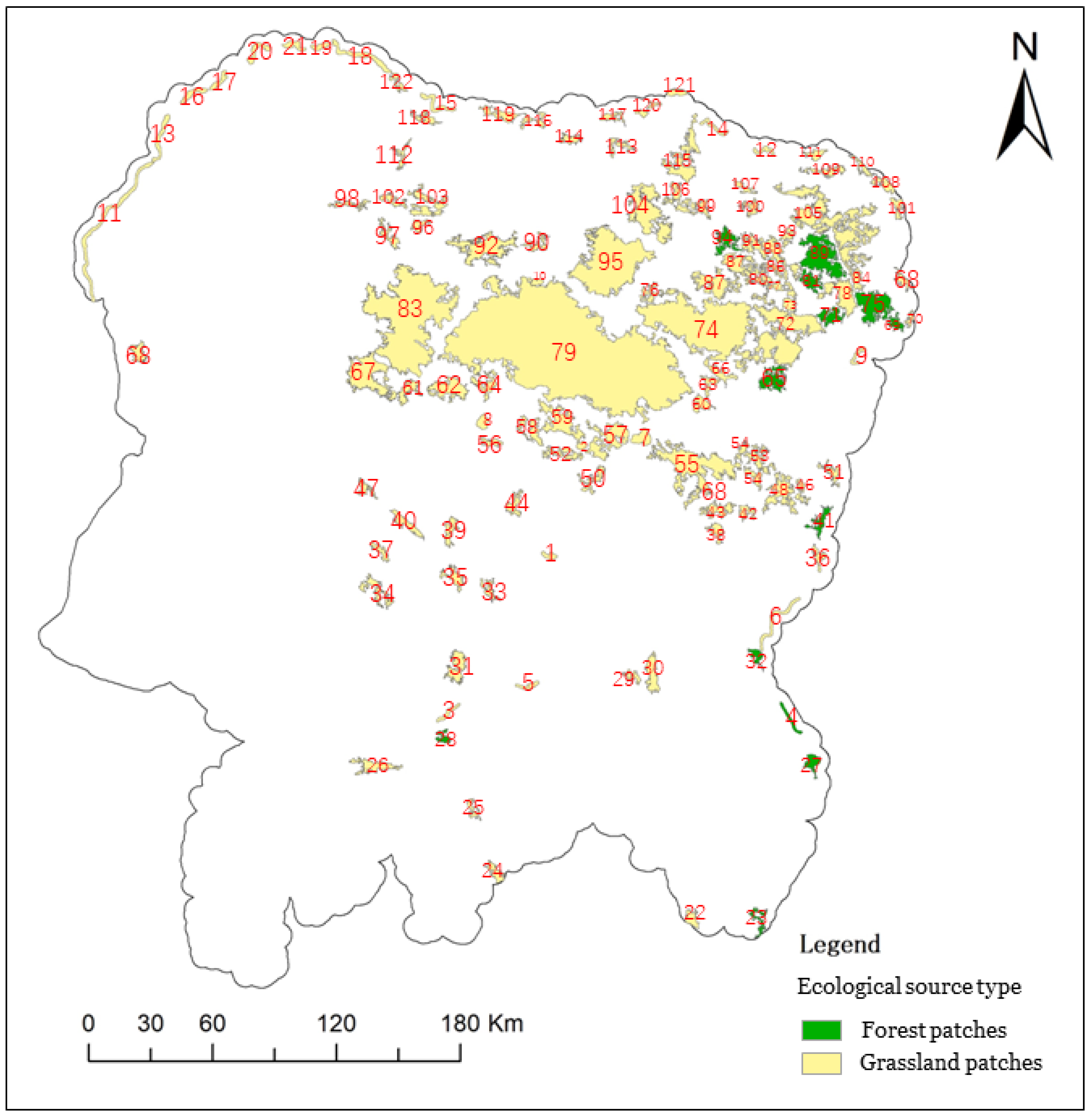
Appendix B
| Factor | Weight | Level | Value | Factor | Weight | Level | Value |
|---|---|---|---|---|---|---|---|
| DEM(m) | 1 | 544–1059 | Habitat risk | 20 | 61.52–82.58 | ||
| 5 | 1059–1206 | 15 | 52.29–61.52 | ||||
| 0.07 | 10 | 1206–1333 | 0.19 | 10 | 45.72–52.29 | ||
| 15 | 1333–1482 | 5 | 37.98–45.72 | ||||
| 20 | 1482–2149 | 1 | 0–37.98 | ||||
| Road Network Density | 1 | 0–2.57 | Water Network Density | 20 | 0–2.15 | ||
| 5 | 2.57–6.48 | 15 | 2.15–6.10 | ||||
| 0.09 | 10 | 6.48–10.78 | 0.12 | 10 | 6.10–10.71 | ||
| 15 | 10.78–16.74 | 5 | 10.71–17.77 | ||||
| 20 | 16.74–30.05 | 1 | 17.77–31.11 | ||||
| NDVI | 20 | −0.13–0.24 | SLOPE () | 1 | 0–3.94 | ||
| 15 | 0.24–0.37 | 5 | 3.94–9.08 | ||||
| 0.18 | 10 | 0.37–0.51 | 0.09 | 10 | 9.08–16.05 | ||
| 5 | 0.51–0.67 | 15 | 16.05–24.53 | ||||
| 1 | 0.67–1 | 20 | 24.53–77.52 | ||||
| LUCC | 1 | Water Wetland | |||||
| 5 | Forest Grassland Shrubland | ||||||
| 0.26 | 10 | Cultivated land | |||||
| 15 | Artificial Surface | ||||||
| 20 | Bare land |
References
- Devi, N.B.; Lepcha, N.T. Carbon sink and source function of Eastern Himalayan forests: Implications of change in climate and biotic variables. Environ. Monit. Assess. 2023, 195, 843. [Google Scholar] [CrossRef] [PubMed]
- Liu, J.; Gao, W.; Liu, T.; Dai, L.; Wu, L.; Miao, H.; Yang, C. A Bibliometric Analysis of the Impact of Ecological Restoration on Carbon Sequestration in Eco-systems. Forests 2023, 14, 1442. [Google Scholar] [CrossRef]
- Chen, Z.; Chen, J.; Xu, G.; Sha, Z.; Yin, J.; Li, Z. Estimation and Climate Impact Analysis of Terrestrial Vegetation Net Primary Productivity in China from 2001 to 2020. Land 2023, 12, 1223. [Google Scholar] [CrossRef]
- He, N.; Wen, D.; Zhu, J.; Tang, X.; Xu, L.; Zhang, L.; Hu, H.; Huang, M.; Yu, G. Vegetation carbon sequestration in Chinese forests from 2010 to 2050. Glob. Chang. Biol. 2016, 23, 1575–1584. [Google Scholar] [CrossRef]
- Wang, Z.; Li, R.; Guo, Q.; Wang, Z.; Huang, M.; Cai, C.; Chen, B. Learning ensembles of process-based models for high accurately evaluating the one-hundred-year carbon sink potential of China’s forest ecosystem. Heliyon 2023, 9, e17243. [Google Scholar] [CrossRef]
- Li, H.; Gao, W.; Liu, Y.; Yuan, F.; Wu, M.; Meng, L. Attributing the impacts of ecological engineering and climate change on carbon uptake in Northeastern China. Landsc. Ecol. 2023, 1–16. [Google Scholar] [CrossRef]
- Zhao, J.; Ma, J.; Zhu, Y.-F.; Yu, H.-C.; Zhang, Q.; Chen, F. Effects of Vegetation Types on Carbon Cycle Functional Genes in Reclaimed Soil from Open Pit Mines in the Loess Plateau. Huan Jing Ke Xue Huanjing Kexue 2023, 44, 3386–3395. [Google Scholar] [CrossRef]
- Heikkala, E. The Effects of Land-Use Changes on Forest Carbon Storage—The Case of New Building Scenario 2016–2050 for the Uusimaa Region. Master’s Thesis, Aalto University, Espoo, Finland, 2023. [Google Scholar]
- Chen, X.; Zhang, Y. Impacts of climate, phenology, elevation and their interactions on the net primary productivity of vegetation in Yunnan, China under global warming. Ecol. Indic. 2023, 154, 110533. [Google Scholar] [CrossRef]
- Xu, C.; Zhang, Q.; Yu, Q.; Wang, J.; Wang, F.; Qiu, S.; Ai, M.; Zhao, J. Effects of land use/cover change on carbon storage between 2000 and 2040 in the Yellow River Basin, China. Ecol. Indic. 2023, 151, 110345. [Google Scholar] [CrossRef]
- Tu, H.; Jiapaer, G.; Yu, T.; Zhang, L.; Chen, B.; Lin, K.; Li, X. Effects of Land Cover Change on Vegetation Carbon Source/Sink in Arid Terrestrial Ecosystems of Northwest China, 2001–2018. Remote. Sens. 2023, 15, 2471. [Google Scholar] [CrossRef]
- Landi, P.; Minoarivelo, H.O.; Brännström, U.; Hui, C.; Dieckmann, U. Complexity and stability of ecological networks: A review of the theory. Popul. Ecol. 2018, 60, 319–345. [Google Scholar] [CrossRef]
- Wei, S.; Pan, J.; Liu, X. Landscape ecological safety assessment and landscape pattern optimization in arid inland river basin: Take Ganzhou District as an example. Hum. Ecol. Risk Assess. Int. J. 2020, 26, 782–806. [Google Scholar] [CrossRef]
- Luo, J.; Fu, H. Construct the future wetland ecological security pattern with multi-scenario simulation. Ecol. Indic. 2023, 153, 110473. [Google Scholar] [CrossRef]
- Borrett, S.R.; Sheble, L.; Moody, J.; Anway, E.C. Bibliometric review of ecological network analysis: 2010–2016. Ecol. Model. 2018, 382, 63–82. [Google Scholar] [CrossRef]
- An, Y.; Liu, S.; Sun, Y.; Shi, F.; Beazley, R. Construction and optimization of an ecological network based on morphological spatial pattern analysis and circuit theory. Landsc. Ecol. 2021, 36, 2059–2076. [Google Scholar] [CrossRef]
- Wang, X.; Sun, Y.; Liu, Q.; Zhang, L. Construction and Optimization of Ecological Network Based on Landscape Ecological Risk Assessment: A Case Study in Jinan. Land 2023, 12, 743. [Google Scholar] [CrossRef]
- Wang, C.; Yu, W.; Ma, L.; Ye, X.; Erdenebileg, E.; Wang, R.; Huang, Z.; Indree, T.; Liu, G. Biotic and abiotic drivers of ecosystem multifunctionality: Evidence from the semi-arid grasslands of northern China. Sci. Total. Environ. 2023, 887, 164158. [Google Scholar] [CrossRef]
- Mei, Y.; Sun, Y.; Wang, Q.; Liu, Q.; Zhang, L. Construction of Green Space Ecological Network in Jinan City Based on MSPA and MCR Model. Pol. J. Environ. Stud. 2022, 31, 3701–3711. [Google Scholar] [CrossRef]
- Cui, L.; Wang, J.; Sun, L.; Lv, C. Construction and optimization of green space ecological networks in urban fringe areas: A case study with the urban fringe area of Tongzhou district in Beijing. J. Clean. Prod. 2020, 276, 124266. [Google Scholar] [CrossRef]
- Zhu, L.; Sun, W.; Wu, J.; Fan, D. Spatiotemporal Distribution of Carbon Sink Indicators—NPP and Its Driving Analysis in Ordos City, China. Appl. Sci. 2023, 13, 6457. [Google Scholar] [CrossRef]
- Barabás, G.; Michalska-Smith, M.J.; Allesina, S. Self-regulation and the stability of large ecological networks. Nat. Ecol. Evol. 2017, 1, 1870–1875. [Google Scholar] [CrossRef] [PubMed]
- Hu, G.-Z.; Ha, G.; Li, M.-J.; Yu, P.-D.; Ga, Q.-Z. Study on the simulation of soil carbon sink in grassland ecological management in China—Based on IPCC inventory method. Adv. Clim. Change Res. 2023, 19, 371. [Google Scholar]
- Lu, R.; Yu, W.; Lü, J.; Xue, A. Synchronization on complex networks of networks. IEEE Trans. Neural Netw. Learn. Syst. 2014, 25, 2110–2118. [Google Scholar] [CrossRef] [PubMed]
- Domínguez-García, V.; Dakos, V.; Kéfi, S. Unveiling dimensions of stability in complex ecological networks. Proc. Natl. Acad. Sci. USA 2019, 116, 25714–25720. [Google Scholar] [CrossRef]
- Guo, Y.; Ren, Z.; Dong, Y.; Zhang, P.; Wang, C.; Ma, Z.; He, X. Multifunctionality can be promoted by increasing agriculture-dominated heterogeneous landscapes in an agro-forestry interlacing zone in northeast China. Landsc. Urban Plan. 2023, 238, 104832. [Google Scholar] [CrossRef]
- Jia, X.; Han, H.; Feng, Y.; Song, P.; He, R.; Liu, Y.; Wang, P.; Zhang, K.; Du, C.; Ge, S.; et al. Scale-dependent and driving relationships between spatial features and carbon storage and sequestration in an urban park of Zhengzhou, China. Sci. Total Environ. 2023, 894, 164916. [Google Scholar] [CrossRef]
- Triviño, M.; Juutinen, A.; Mazziotta, A.; Miettinen, K.; Podkopaev, D.; Reunanen, P.; Mönkkönen, M. Managing a boreal forest landscape for providing timber, storing and sequestering carbon. Ecosyst. Serv. 2015, 14, 179–189. [Google Scholar] [CrossRef]
- Xu, H.; Zhang, Z.; Yu, X.; Li, T.; Chen, Z. The construction of an ecological security pattern based on the comprehensive evaluation of the importance of ecosystem service and ecological sensitivity: A case of Yangxin County, Hubei Province. Front. Environ. Sci. 2023, 11, 1154166. [Google Scholar] [CrossRef]
- Shin, G.; Kim, H.-R.; Jang, S.-R.; Kim, H.-Y.; Rho, P. Evaluating the Criteria and Weight Value for Ecological Network Connectivity of Baekdudaegan Mountain Range on Taebaeksan National Park. Korean J. Environ. Ecol. 2019, 33, 292–302. [Google Scholar] [CrossRef]
- Yupan, Z.; Huan, Y.; Guangbin, L.; Ainong, L.; Jinhu, B.; Xi, N. Identification of Ecological Network in Mekong River Basin based on Ecological Risk Assessment. Remote Sens. Technol. Appl. 2023, 38, 116–128. [Google Scholar]
- Riviere, M.; Caurla, S. Landscape implications of managing forests for carbon sequestration. Forestry 2021, 94, 70–85. [Google Scholar] [CrossRef]
- Lin, Y.; Cong, N.; Xiao, J.; Kou, Y.; Li, Y.; Yu, X.; Qi, G.; Gou, C.; Bai, Y.; Ren, P. Projecting future aboveground carbon sequestration rate of alpine forest on the eastern Tibetan Plateau in response to climate change. Front. Plant Sci. 2023, 14, 1212406. [Google Scholar] [CrossRef]
- Wu, M.M.; Liang, Y.; Taubert, F.; Huth, A.; Zhang, M.; Wang, X. Sensitivity of forest composition and productivity to climate change in mixed broadleaved-Korean pine forest of Northeastern China. Ecol. Model. 2023, 483, 110434. [Google Scholar] [CrossRef]
- Kang, J.; Qing, Y.; Lu, W. Construction and optimization of the Saihanba ecological network. Ecol. Indic. 2023, 153, 110401. [Google Scholar] [CrossRef]
- Straus, H.; Podvinšek, S.; Klopčič, M. Identifying Optimal Forest Management Maximizing Carbon Sequestration in Mountain Forests Impacted by Natural Disturbances: A Case Study in the Alps. Forests 2023, 14, 947. [Google Scholar] [CrossRef]
- Yu, Q.; Yue, D.; Wang, Y.; Kai, S.; Fang, M.; Ma, H.; Zhang, Q.; Huang, Y. Optimization of ecological node layout and stability analysis of ecological network in desert oasis: A typical case study of ecological fragile zone located at Deng Kou County (Inner Mongolia). Ecol. Indic. 2018, 84, 304–318. [Google Scholar] [CrossRef]
- Xu, W.; Wang, J.; Zhang, M.; Li, S. Construction of landscape ecological network based on landscape ecological risk assessment in a large-scale opencast coal mine area. J. Clean. Prod. 2020, 286, 125523. [Google Scholar] [CrossRef]
- Guo, H.; Sun, Y.; Wang, Q.; Wang, X.; Zhang, L. Construction of Greenspace Landscape Ecological Network Based on Resistance Analysis of GeoDetector in Jinan. Stoch. Environ. Res. Risk Assess. 2023, 37, 651–663. [Google Scholar] [CrossRef]
- Sharp, R.; Douglass, J.; Wolny, S.; Arkema, K.; Bernhardt, J.; Bierbower, W.; Chaumont, N.; Denu, D.; Fisher, D.; Glowinski, K.; et al. InVEST 3.9.0 User’s Guide [M/OL]. 2020. Available online: http://releases.naturalcapitalproject.org/invest-userguide/latest/index.html (accessed on 12 December 2020).
- Wyatt, K.H.; Griffin, R.; Guerry, A.D.; Ruckelshaus, M.; Fogarty, M.; Arkema, K.K. Habitat Risk Assessment for Regional Ocean Planning in the US Northeast and Mid-Atlantic. PLoS ONE 2017, 12, e0188776. [Google Scholar] [CrossRef]
- Nie, X.R.; Hu, Z.Q.; Zhu, Q.; Ruan, M.Y. Research on temporal and spatial resolution and the driving forces of ecological environment quality in coal mining areas considering topographic correction. Remote Sens. 2021, 13, 2815. [Google Scholar] [CrossRef]
- Xu, H.Q.; Wang, Y.F.; Guan, H.D.; Shi, T.T.; Hu, X.S. Detecting ecological changes with a remote sensing based ecological index (RSEI) produced time series and change vector analysis. Remote Sens. 2019, 11, 2345. [Google Scholar] [CrossRef]
- Liang, X.; Liu, Z.; Zhai, L.; Ji, L.; Feng, Y.; Sang, H. Spatial terrestrial carbon emissions/sequestrations evolution based on ecological network analysis in Bei-jing-Tianjin-Hebei urban agglomeration. Ecol. Eng. 2023, 189, 106914. [Google Scholar] [CrossRef]
- Lü, L.; Pan, L.; Zhou, T.; Zhang, Y.-C.; Stanley, H.E. Toward link predictability of complex networks. Proc. Natl. Acad. Sci. USA 2015, 112, 2325–2330. [Google Scholar] [CrossRef] [PubMed]
- Wu, J.; Fan, X.; Li, K.; Wu, Y. Assessment of ecosystem service flow and optimization of spatial pattern of supply and demand matching in Pearl River Delta, China. Ecol. Indic. 2023, 153, 110452. [Google Scholar] [CrossRef]
- Lü, L.; Chen, D.; Ren, X.-L.; Zhang, Q.-M.; Zhang, Y.-C.; Zhou, T. Vital nodes identification in complex networks. Phys. Rep. 2016, 650, 1–63. [Google Scholar] [CrossRef]
- Chen, Y.Q.; Li, Y.F.; Qi, X.H.; Chen, W.H.; Lin, J.H. Assessing ecosystem risk in coastal wetland of the South Fujian Golden Delta using a habitat risk assessment model based on the land-use effect on tidal flat wetland. Acta Ecol. Sin. 2018, 38, 4214–4225. [Google Scholar]
- Guo, H.; Yu, Q.; Pei, Y.; Wang, G.; Yue, D. Optimization of landscape spatial structure aiming at achieving carbon neutrality in desert and mining areas. J. Clean. Prod. 2021, 322, 129156. [Google Scholar] [CrossRef]
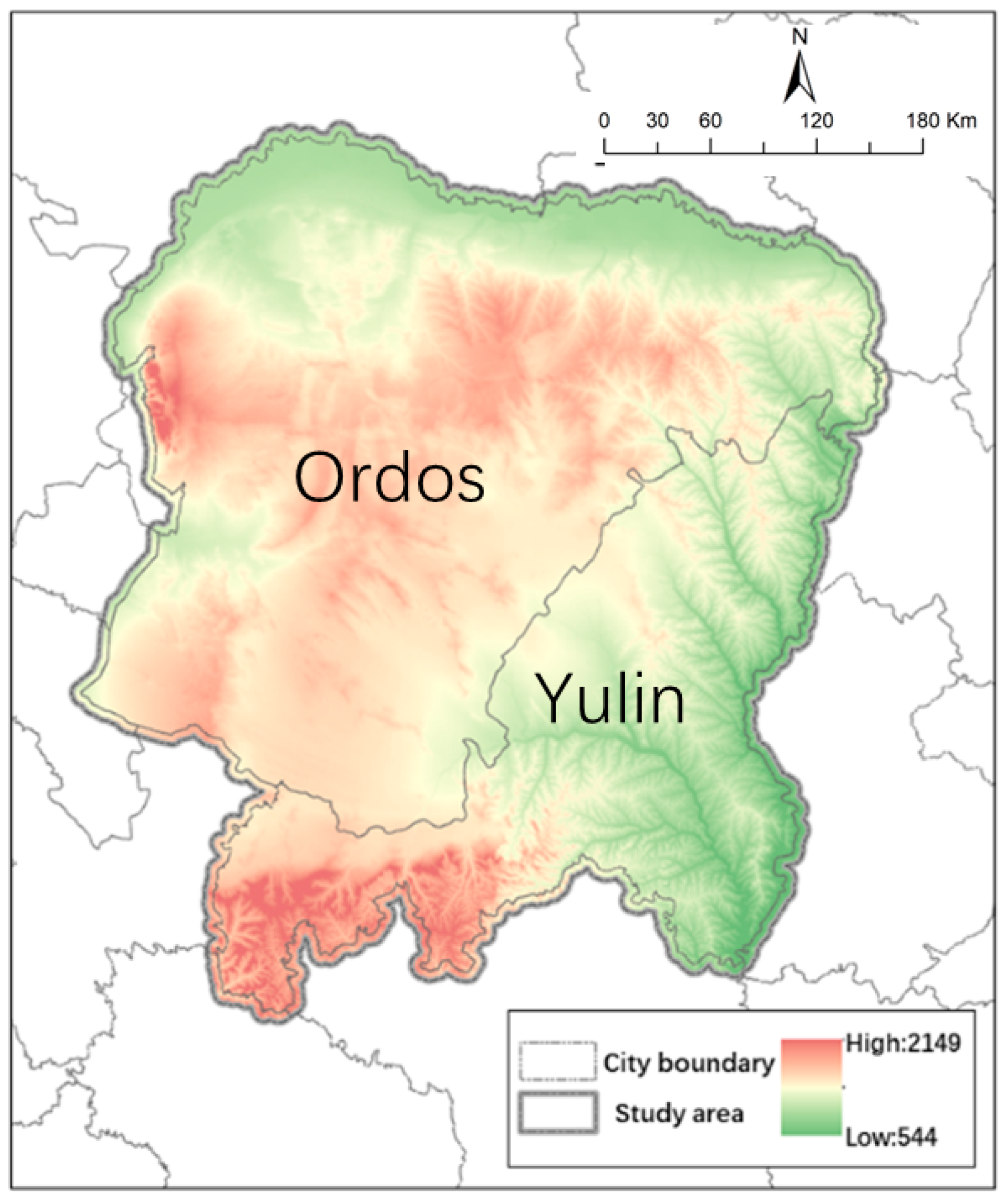

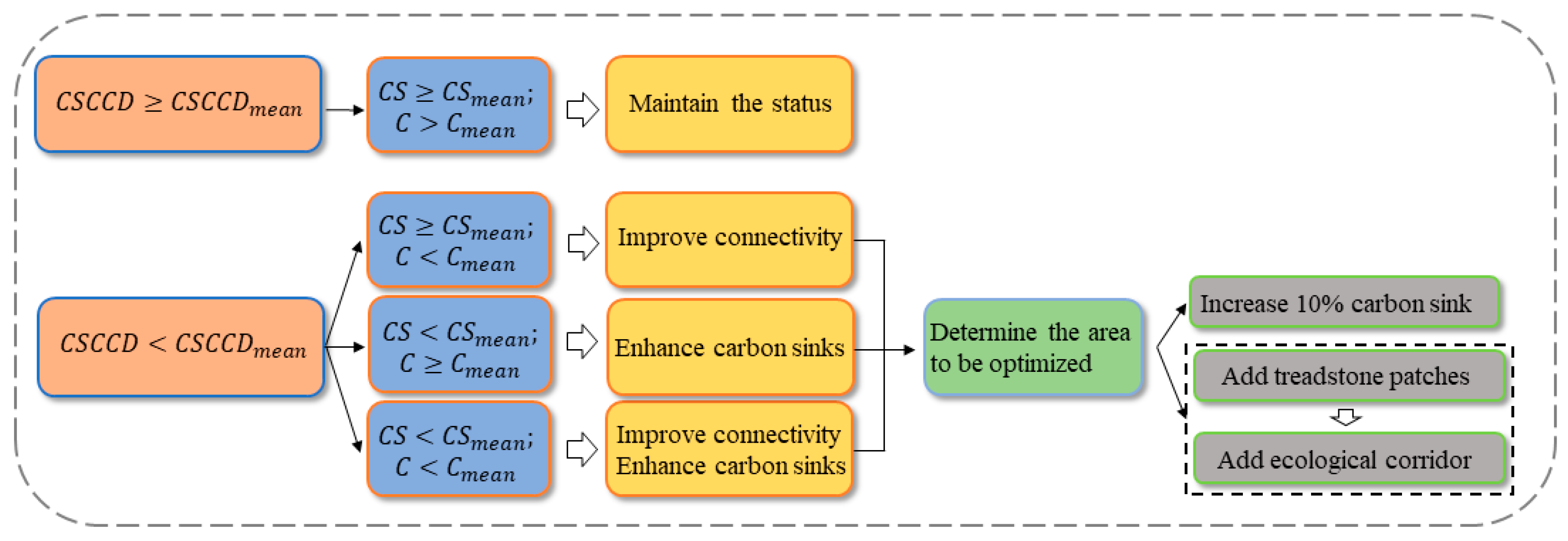
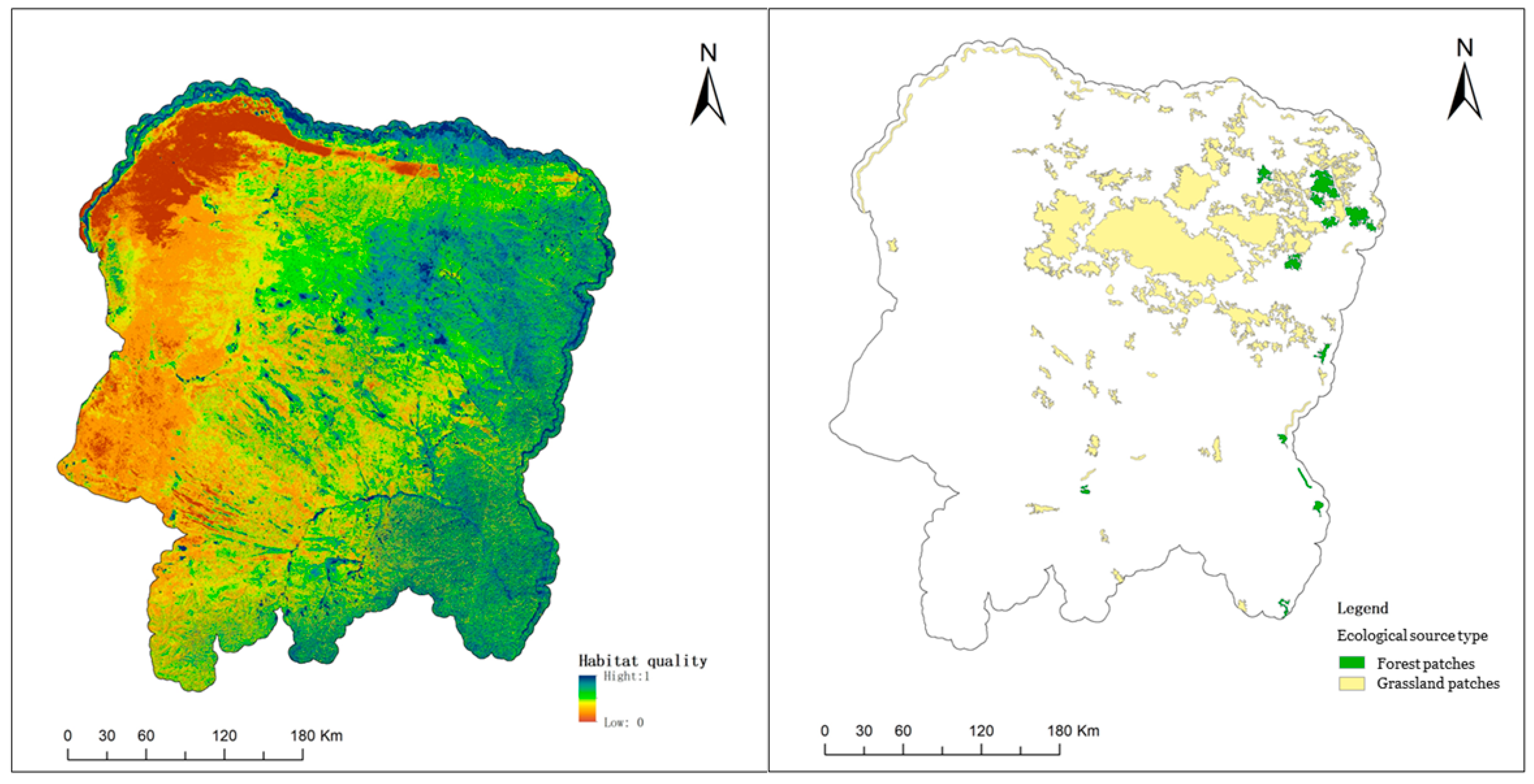

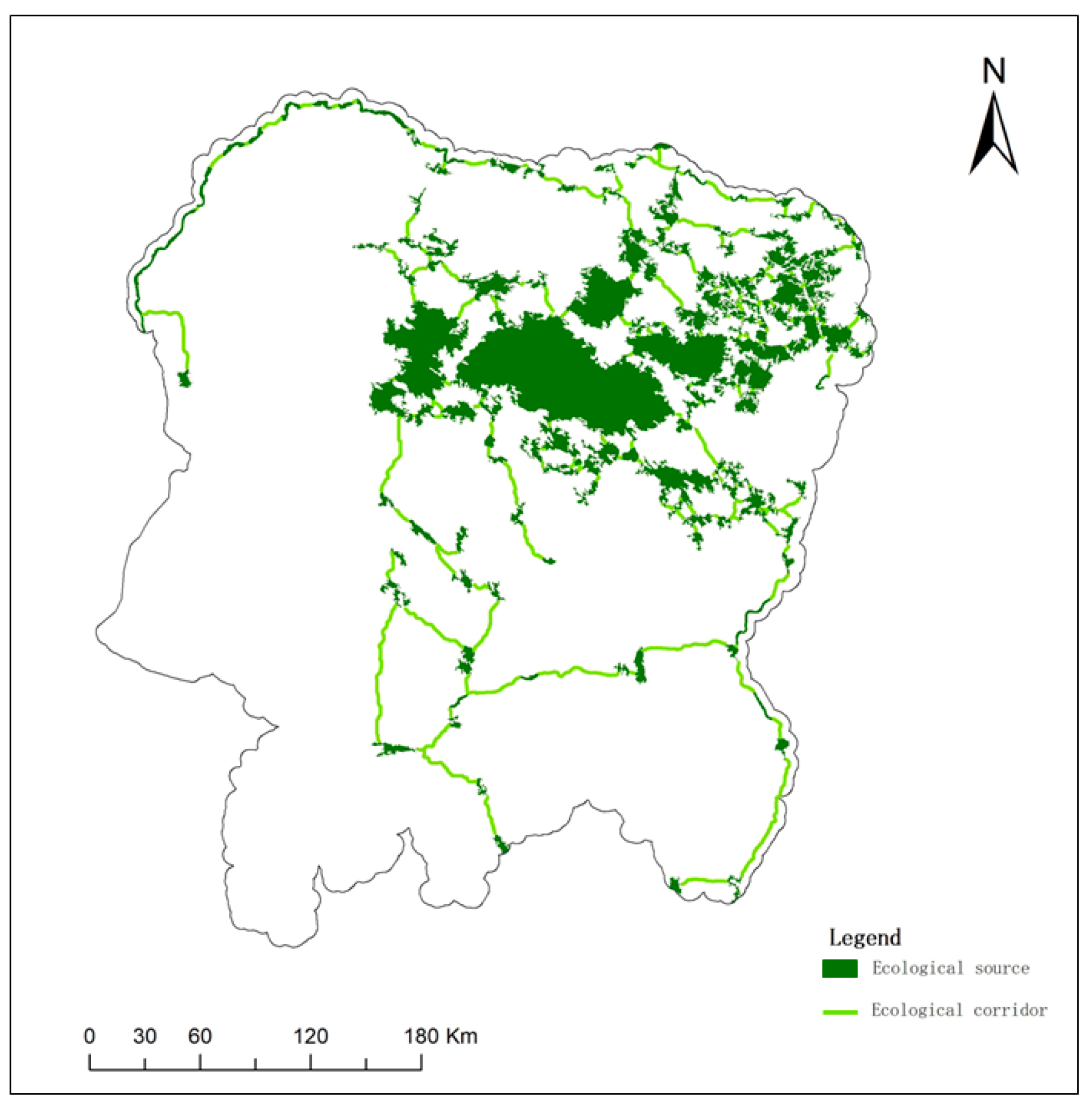
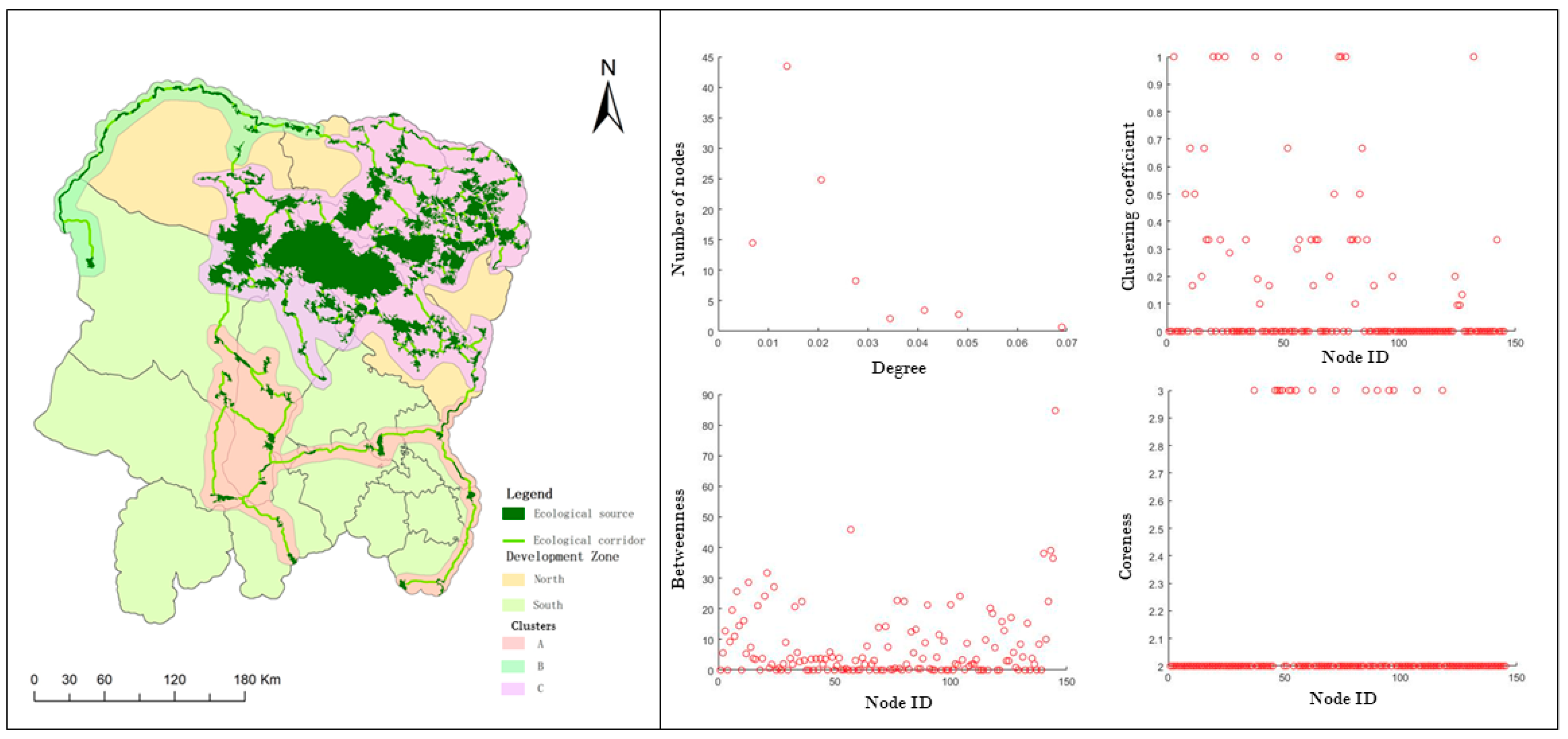

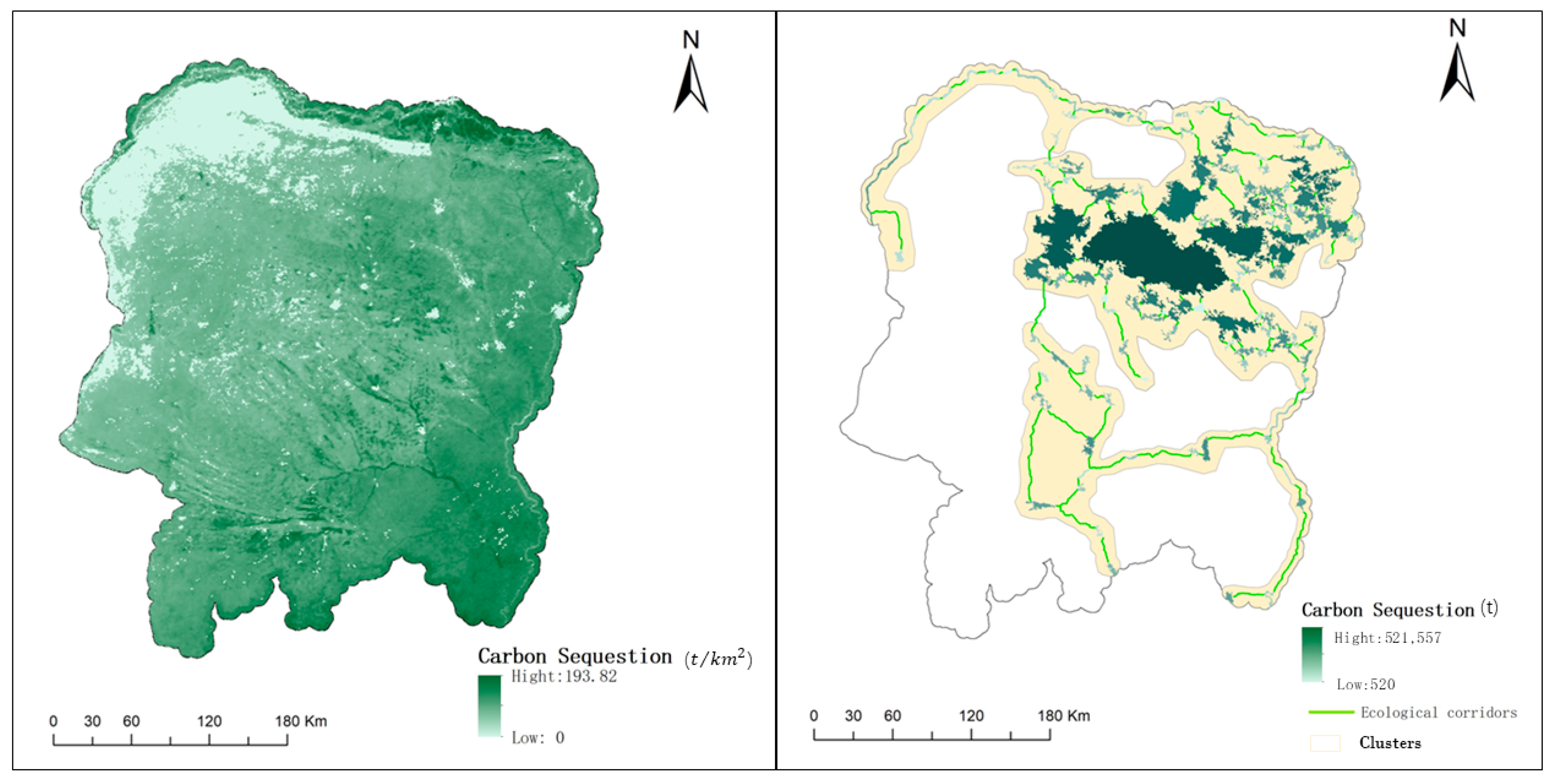

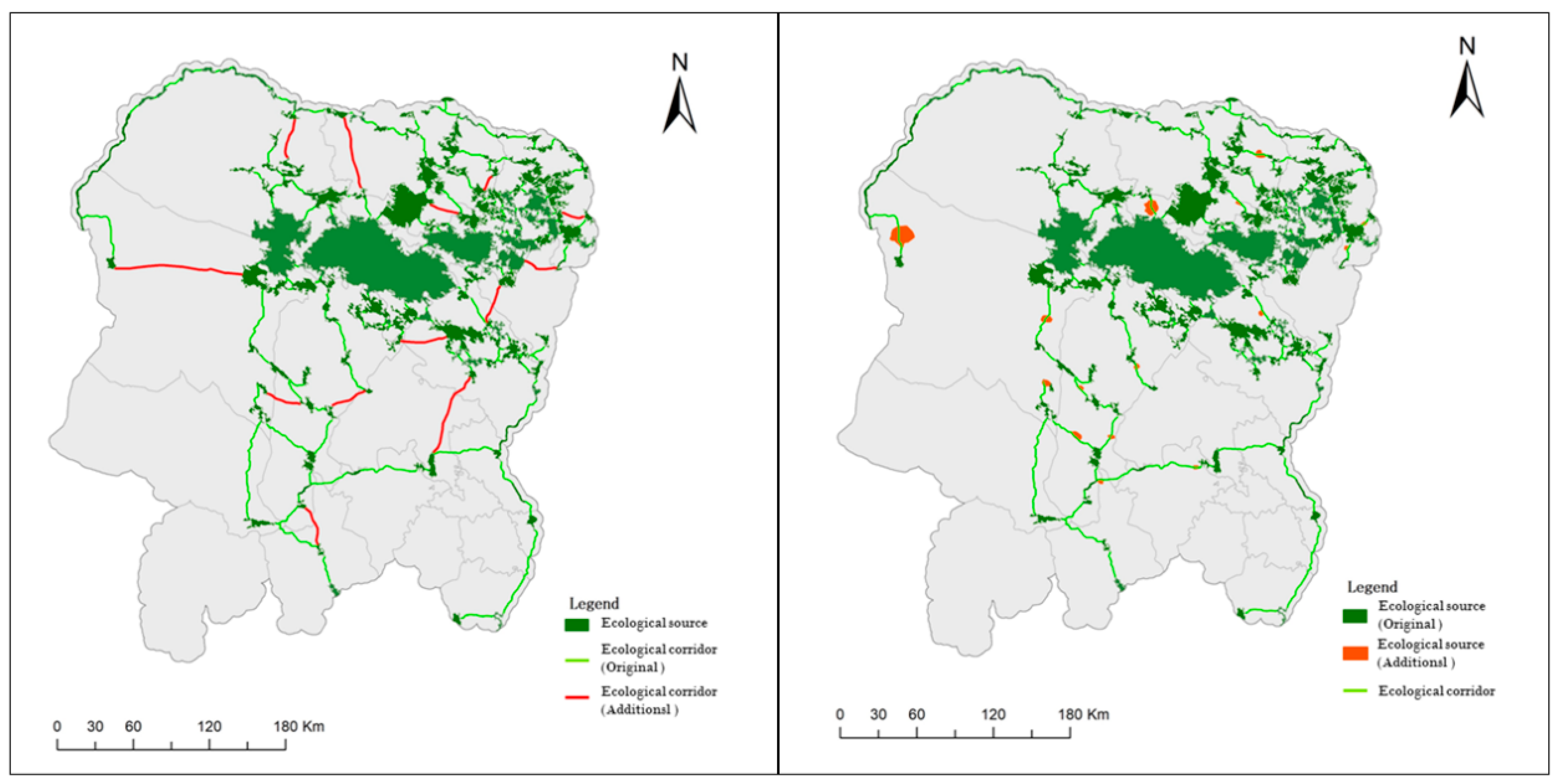
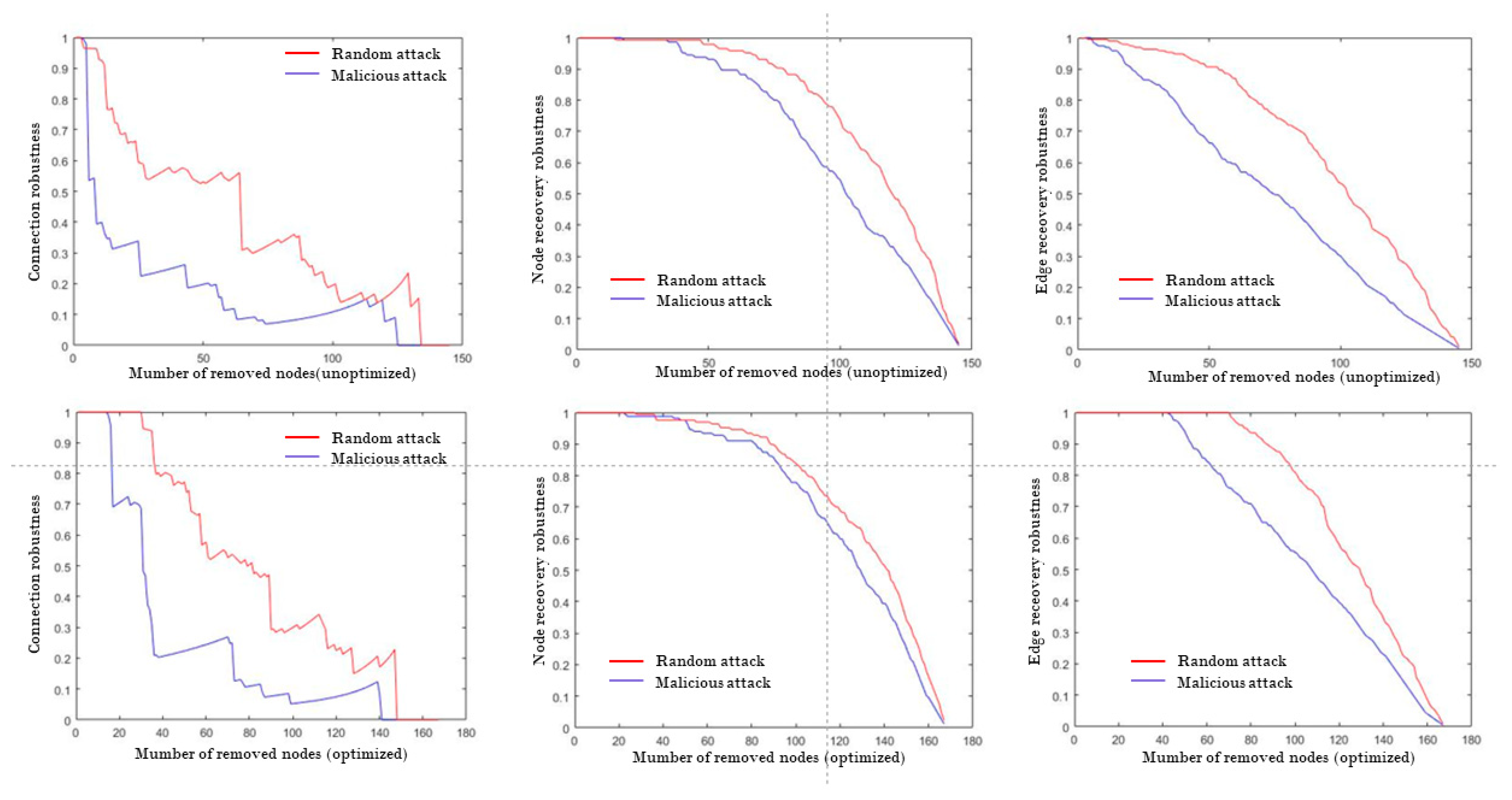
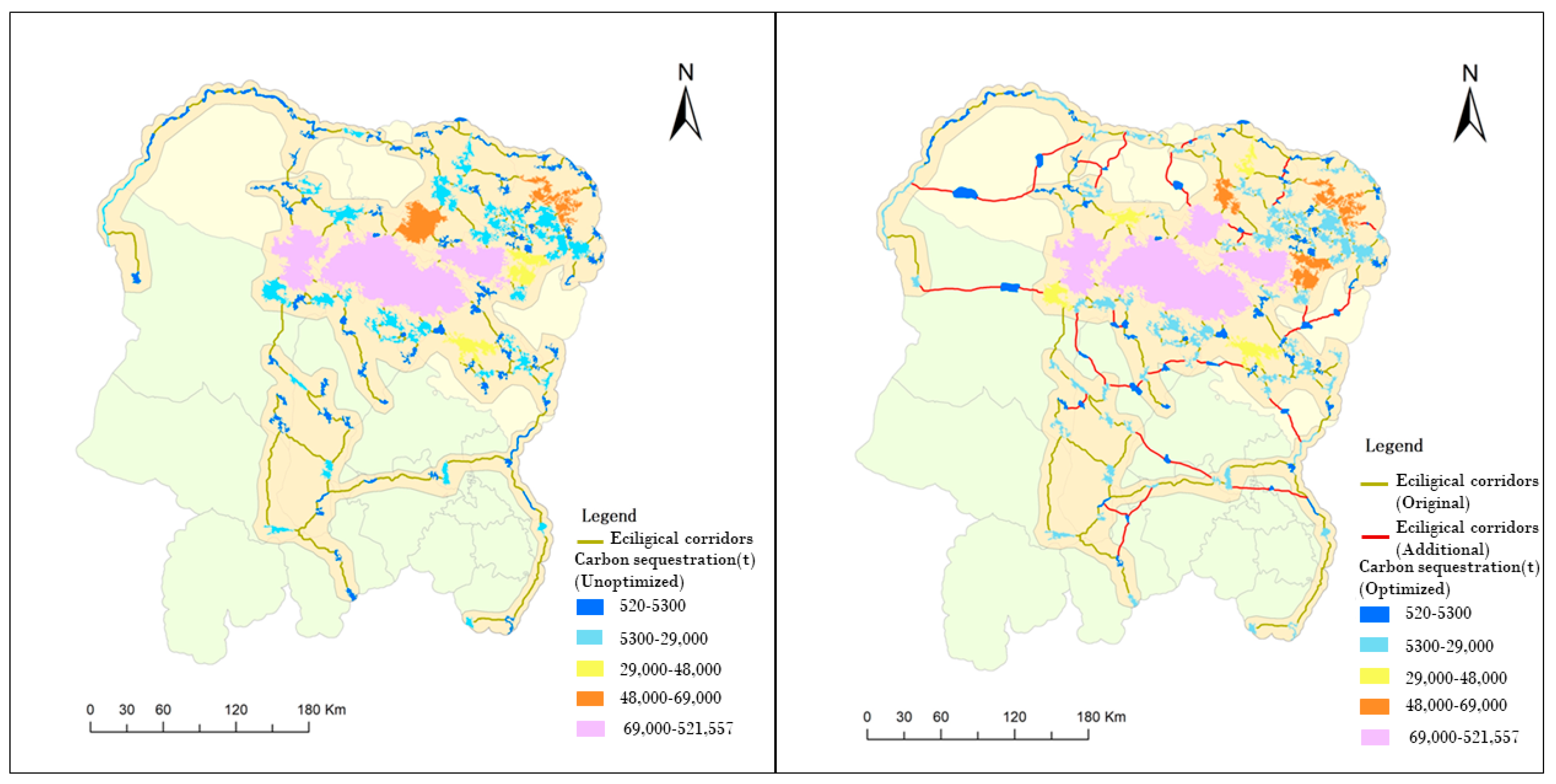
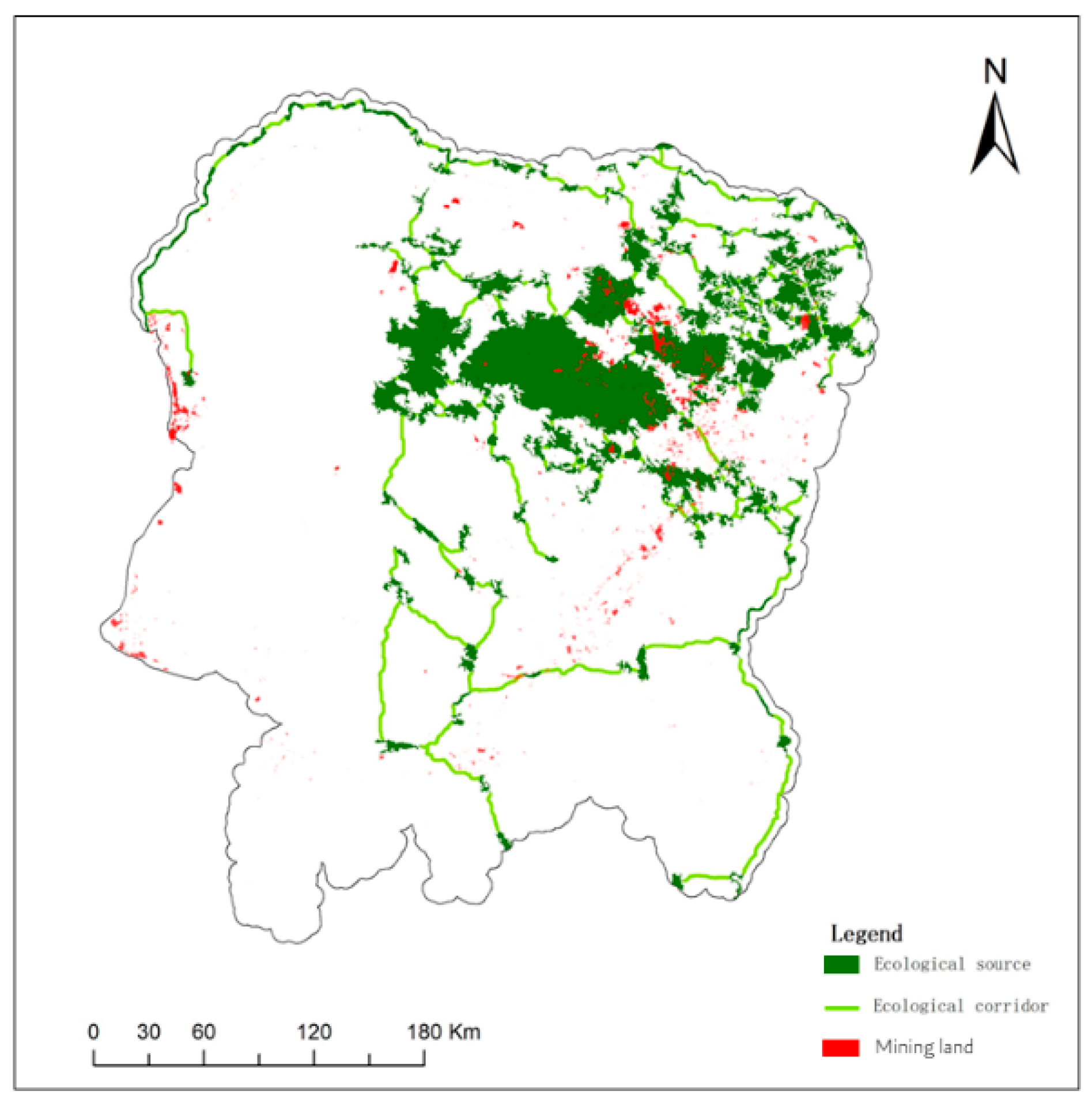
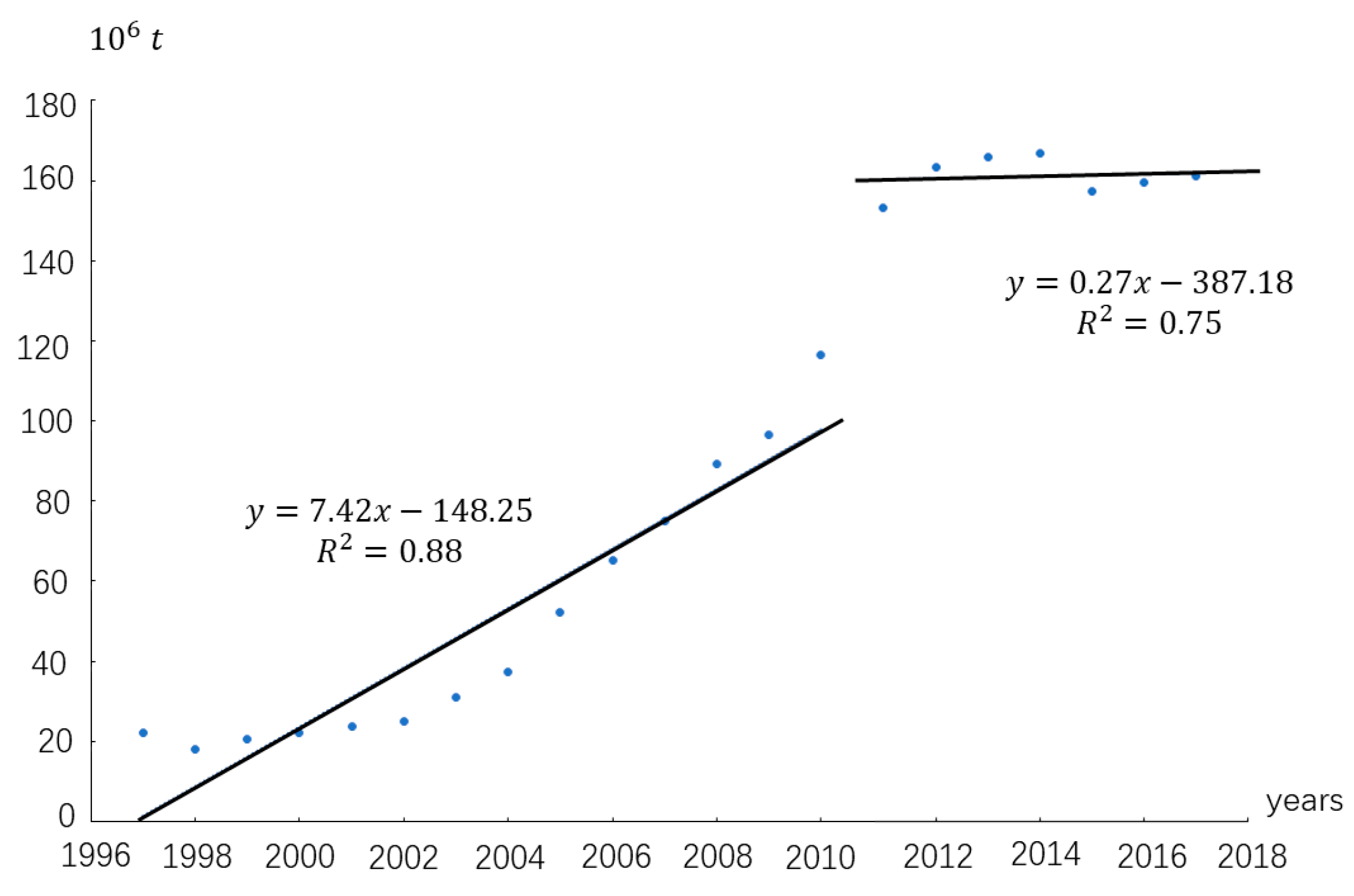
| Status of F&GES | Carbon Sequestration in Ecological Sources (t) | Carbon Sequestration in Ecological Corridors (t) | Total Carbon Sequestration (t) |
|---|---|---|---|
| Before optimization | 1,688,448 | 13,507 | 1,701,956 |
| After optimization | 1,801,062 | 16,209 | 1,817,272 |
Disclaimer/Publisher’s Note: The statements, opinions and data contained in all publications are solely those of the individual author(s) and contributor(s) and not of MDPI and/or the editor(s). MDPI and/or the editor(s) disclaim responsibility for any injury to people or property resulting from any ideas, methods, instructions or products referred to in the content. |
© 2023 by the authors. Licensee MDPI, Basel, Switzerland. This article is an open access article distributed under the terms and conditions of the Creative Commons Attribution (CC BY) license (https://creativecommons.org/licenses/by/4.0/).
Share and Cite
Wang, G.; Yue, D.; Yu, Q.; Yang, D.; Xu, C.; Wang, F. Study on Forest and Grassland Ecological Space Structure in Eyu Mining Area and Potential Alternatives for Enhancing Carbon Sequestration. Forests 2023, 14, 1587. https://doi.org/10.3390/f14081587
Wang G, Yue D, Yu Q, Yang D, Xu C, Wang F. Study on Forest and Grassland Ecological Space Structure in Eyu Mining Area and Potential Alternatives for Enhancing Carbon Sequestration. Forests. 2023; 14(8):1587. https://doi.org/10.3390/f14081587
Chicago/Turabian StyleWang, Ge, Depeng Yue, Qiang Yu, Di Yang, Chenglong Xu, and Fei Wang. 2023. "Study on Forest and Grassland Ecological Space Structure in Eyu Mining Area and Potential Alternatives for Enhancing Carbon Sequestration" Forests 14, no. 8: 1587. https://doi.org/10.3390/f14081587
APA StyleWang, G., Yue, D., Yu, Q., Yang, D., Xu, C., & Wang, F. (2023). Study on Forest and Grassland Ecological Space Structure in Eyu Mining Area and Potential Alternatives for Enhancing Carbon Sequestration. Forests, 14(8), 1587. https://doi.org/10.3390/f14081587







